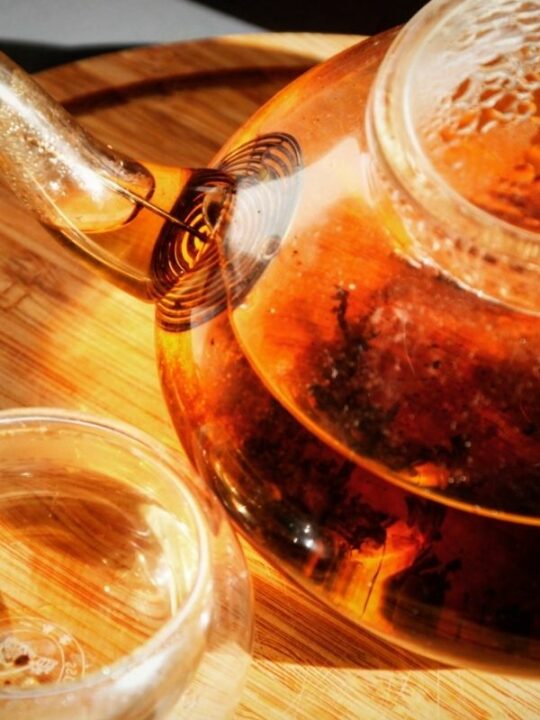Pairing your tea with the right foods can be just as fine an art as wine pairing.
You may have heard about the best foods to pair with green tea and black tea, but have you ever wondered what the best foods to accompany Pu’erh tea are?
Pu’erh tea is a fermented tea with a history as rich and complex as its flavor profile. Pu’erh is made using leaves of the Assamica variety of the tea plant, Camellia senensis, grown in Yunnan, China.
Pu’erh is a full-bodied tea with a lightly pungent, sun-dried taste.
Finding the perfect foods to accompany a pot of Pu’erh can be difficult, because Pu’erh varies so greatly in taste, depending on local processing styles and how long the tea has been aging for.
Pu’erh is one of the most diverse tea categories.
Because Pu’erh contains living bacteria, it is literally constantly changing, and no two brews are exactly alike, even if the tea leaves come from the same teacake.
That said, young Pu’erh tends to be smokier, while older, aged Pu’erh is sweeter and has a dark, fruity aftertaste.
What goes well with Pu’erh tea?
Pu’erh tea has a dark liquor, a smoky flavor, and a full-bodied taste. It has notes of late summer fruits and cacao. Pu’erh pairs well with oily, high-fat foods, such as roasted meats, BBQs, and charred vegetables. It also tastes great with rich desserts, such as dark chocolate.
What is Pu’erh tea, you ask? Pu’erh is made by tossing tea leaves in large works. This process halts oxidation but does not kill the living bacteria in the tea leaves. The bacteria in Pu’erh can live on for decades.
After being toasted in a wok, Pu’erh leaves are dried in the sun. Traditionally, Pu’erh teas are then pressed into round teacakes to make it easy to transport them.
Their pressed round forms make them easy to rotate in aging cellars during the fermentation process. Rotating teacakes improving the airflow around them.
Cakes are conducive to a long and rich aging process because the pressed leaves expose less of their surface area to the air.
This means that the fermentation process happens more slowly, which allows a richer flavor profile to develop.
There are now also Pu’erh teas that can be purchased as loose leaf teas. Shou Pu’erhs are processed using an accelerated fermentation method, which is intended to mimic the effects of long-term storage.
If you aren’t particularly partial to the taste of Pu’erh on its own, look into ways to make Pu’erh tea taste better.
The best food pairings for young “raw” Pu’erh tea
Young raw Pu’erh has a vegetal taste. It has a subtle bitterness and features notes of roasted walnuts and drying hay.
A young raw Pu’erh is the perfect drink to eat with h’ors d’oeuvres, because it has helpful digestive properties.
Here is how to create the perfect cheeseboard to accompany a young “raw” Pu’erh tea.
Look for high-quality aged goudas and other pungent cheeses. You might include a Corsican sheep cheese called U Pecorinu, or a German Limburger, which is a semi-soft cow’s milk Cheese.
You might also opt for an Ardrahan, which is an Irish semi-soft cheese with a gold hue and washed rind.
Add some dried figs, fresh cherries, red grapes, walnuts and a tomato relish, and you are ready to offer your guests a delectable drinking and snacking experience.
Young Pu’erh is also a great drink to enjoy with chicken or stir-fry recipes, because it helps balance out the oily nature of sauteed foods.
It also tastes great with dark chocolate.
The best food pairings for aged “raw” Pu’erh tea
Aged “raw” Pu’erh has a woody, earthy taste and features notes of dark fruit. Its depth and body develop with time as its bitterness diminishes.
Aged “raw” Pu’erh pairs well with oily meats and foods that are high in fat. It makes a perfect complement for Korean-style BBQs and other charred dark meats.
If you are having a barbecue, you might consider brewing up a batch of your favorite Pu’erh and icing it.
Serve iced Pu’erh with a slice of lemon alongside a selection of grilled red meats as part of a delectable summer dinner menu.
Pu’erh’s strong flavors also make it a good match for foods with sauces, including spicy and garlicky sauces. You don’t have to worry about overwhelming the strong flavors of aged Pu’erh tea!
Historically, teahouses were set up along the Silk Road trading route as places for traders and other travelers to rest.
Guests would drink the Pu’erh tea that was being transported along the Silk Road and consume Dim Sum, a Chinese meal that involves eating small portions of a variety of dishes.
Aged “raw” Pu’erh is a perfect complement to a savory Dim Sum meal, featuring things like steamed buns, rice noodle rolls and dumplings.
Pu’erh’s digestive health benefits make it a perfect drink to consume alongside a hearty meal.
The best food pairings for “ripe” Pu’erh tea?
Ripe Pu’erh has been aging for decades. To sip on a “ripe” Pu’erh is to occupy your own little corner of tea history.
Deciding how to you store your Pu’erh tea is also deciding how you want to contribute to the development of a particular and unique Pu’erh flavor profile.
Because of its maturity, “ripe” Pu’erh has a thick, luscious liquor. It has a heavier body and a smoother mouthfeel than “raw” Pu’erh. It features complex notes of mushroom. It is an earthy, malty tea and often has notes of cacao and cherry.
“Ripe” Pu’erh pairs well with rich sweets, including traditional Chinese egg custard tarts. You can also pair “ripe” Pu’erh with rich, dark chocolate desserts.
Try serving a steaming pot of Pu’erh with chocolate ganache truffles or with a traditional French chocolate gateau.
You can also pair “ripe” Pu’erh with a delectable, caramelized apple tarte tatin and a scoop of vanilla ice cream.
